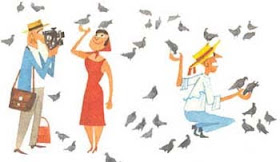Misia Sert, born in the shadows of the Tsars at Tsarkoe Selo in 1872, patron of the arts and composers, friend of the avante gard, definitely had the savoir faire and the courage to carry herself through the many husbands she had and her glittering salons in Paris. Anybody who wanted to be somebody crossed her threshold, as the list of Misia Sert's friends would read like a who's who of the cultural elite of Paris from the end of the Second Empire to World War II.

A gifted pianist she married before she was 16 her first husband Tadeusz Natansan, a Polish émigré politician and journalist, later to become the editor of La Revue blanche magazine. When Natanson was on the brink of bankruptcy, the newspaper magnate Alfred Edwards saved him, on condition that he surrender his wife to him. Duly Misia upheld her part of the bargain and lived with Edwards. Misia's third marriage was to the Spanish painter Jose Maria Sert (1876-1945). She loved Sert, and gave him up when he fell in love with another woman, but kept his name.

She hosted a literary-artistic salon in Paris and acquired considerable influence in Parisian musical and artistic circles, Claude Debussy, as well as painters such as Pierre-Auguste Renoir, Vuillard, and Pierre Bonnard were among her guests. She was a confidante of Pablo Picasso and Jean Cocteau, an early patron of Sergei Diaghilev's Ballets Russes and a close friend of the designer Coco Chanel. The painters painted her and the composers aired their masterpieces at her piano, which she herself could play very well. Her taste was original, penetrating and in most cases definitive. Without directly creating anything, she was some kind of artist herself— rather like Diaghilev, of whom she was the soul-mate and valued adviser. However you had to be of note and gifted even before Misia wanted to know you.
One of the most famous portraits of Misia, is that of Renoir, now hanging in the National Gallery London. Renoir longed to paint Misia with the famous breasts naked, but she would never bare them to him, probably because Edwards was lurking heavily in the adjacent room, ready to exact jealous vengeance even though the artist by that time was an all but total cripple. At one point during her marriage to Edwards, Misia rewarded Renoir for a portrait by giving him a blank cheque. He filled it in with the going rate.

She was one of the models for Toulouse-Lautrec's poster for La Revue Blanche in 1896, in which she is shown as a skater.

Ravel dedicated "Le Cygne" (The Swan) in Histoires naturelles, and La Valse (The Waltz) to her.
Two of her main influences in life who stuck with her to the bitter end were Chanel and Cocteau. In her old age they stuck with her, no matter how old and feeble she had become, not just through the ravages of old age but for the habit of injecting morphine straight through her clothes.

The catalyst for launching others on to stardom, Misia is less remembered than what she should be, and went through life with great savoir faire!
 I remember as a child a wonderful series of children’s books by Miroslav Sasek showcasing different countries around the world. I have two of them (This is London and This is Edinburgh) and they are very battered as I used to read them continuously. Each book takes the reader on an amusing tour throughout the city, and highlights both the landmarks and uniqueness of each location, with wonderful humorous cartoon like illustrations. The books stick to the same format throughout the series. There is usually an illustration of (presumably) Sasek himself going to wherever the book is set on the bottom left inside cover and a similar illustration on the bottom right inside cover which shows him leaving with some kind of local adornment.
I remember as a child a wonderful series of children’s books by Miroslav Sasek showcasing different countries around the world. I have two of them (This is London and This is Edinburgh) and they are very battered as I used to read them continuously. Each book takes the reader on an amusing tour throughout the city, and highlights both the landmarks and uniqueness of each location, with wonderful humorous cartoon like illustrations. The books stick to the same format throughout the series. There is usually an illustration of (presumably) Sasek himself going to wherever the book is set on the bottom left inside cover and a similar illustration on the bottom right inside cover which shows him leaving with some kind of local adornment. The illustrations although a little dated now are as fresh today as what they were when they were first conceived and appeal to young and old alike as there is something for everyone. The books emphasise tourist hotspots, local transport and national dress (particularly the different cultures that inhabit each place). They are in a very 50s, Eastern European style, but are not dated at all. Most of the things that Sasek has picked out are still noteworthy today and his style has endured. They are true classics introducing the cachet and savoir faire of travel to children, that has endured.
The illustrations although a little dated now are as fresh today as what they were when they were first conceived and appeal to young and old alike as there is something for everyone. The books emphasise tourist hotspots, local transport and national dress (particularly the different cultures that inhabit each place). They are in a very 50s, Eastern European style, but are not dated at all. Most of the things that Sasek has picked out are still noteworthy today and his style has endured. They are true classics introducing the cachet and savoir faire of travel to children, that has endured.









































